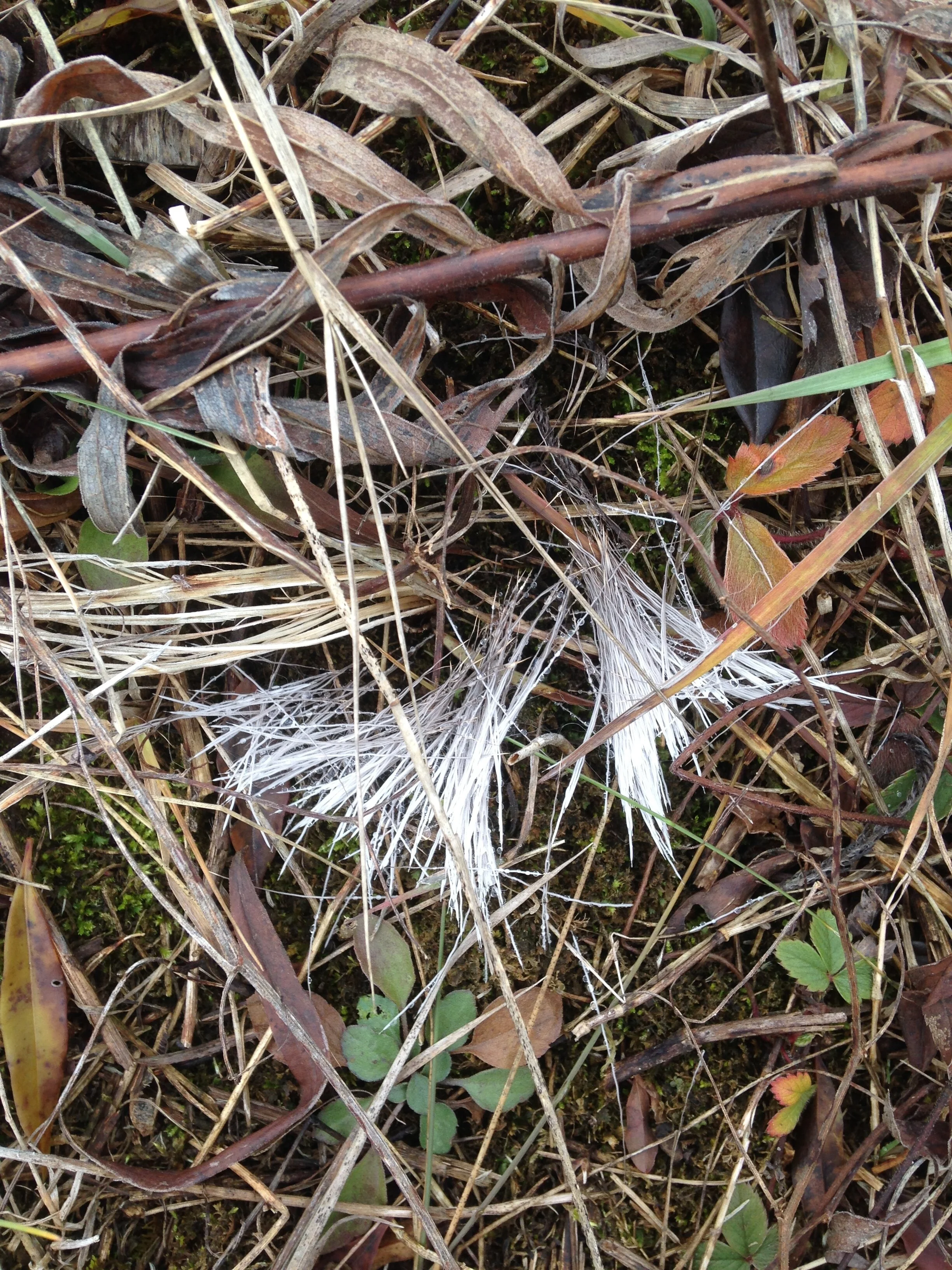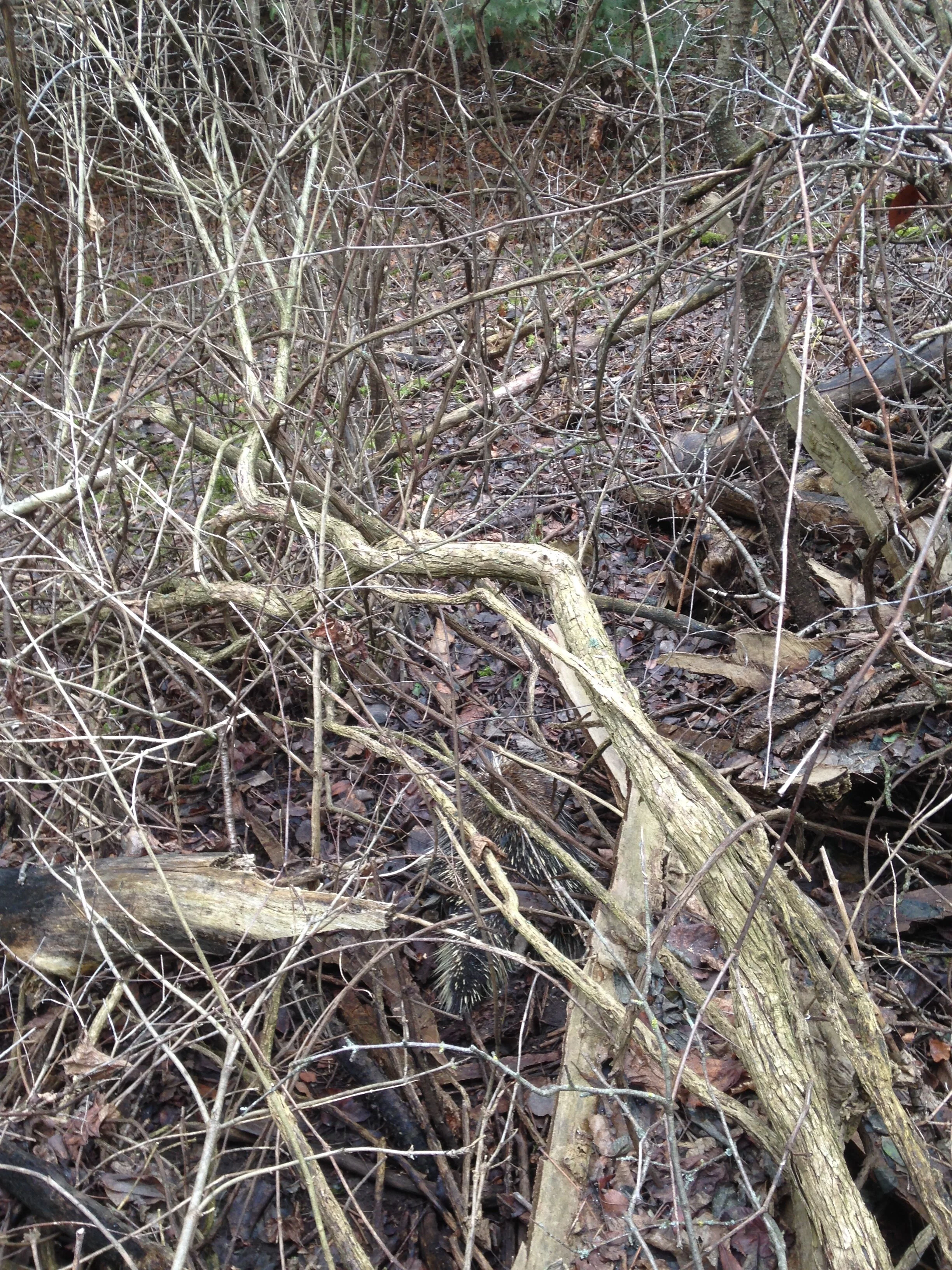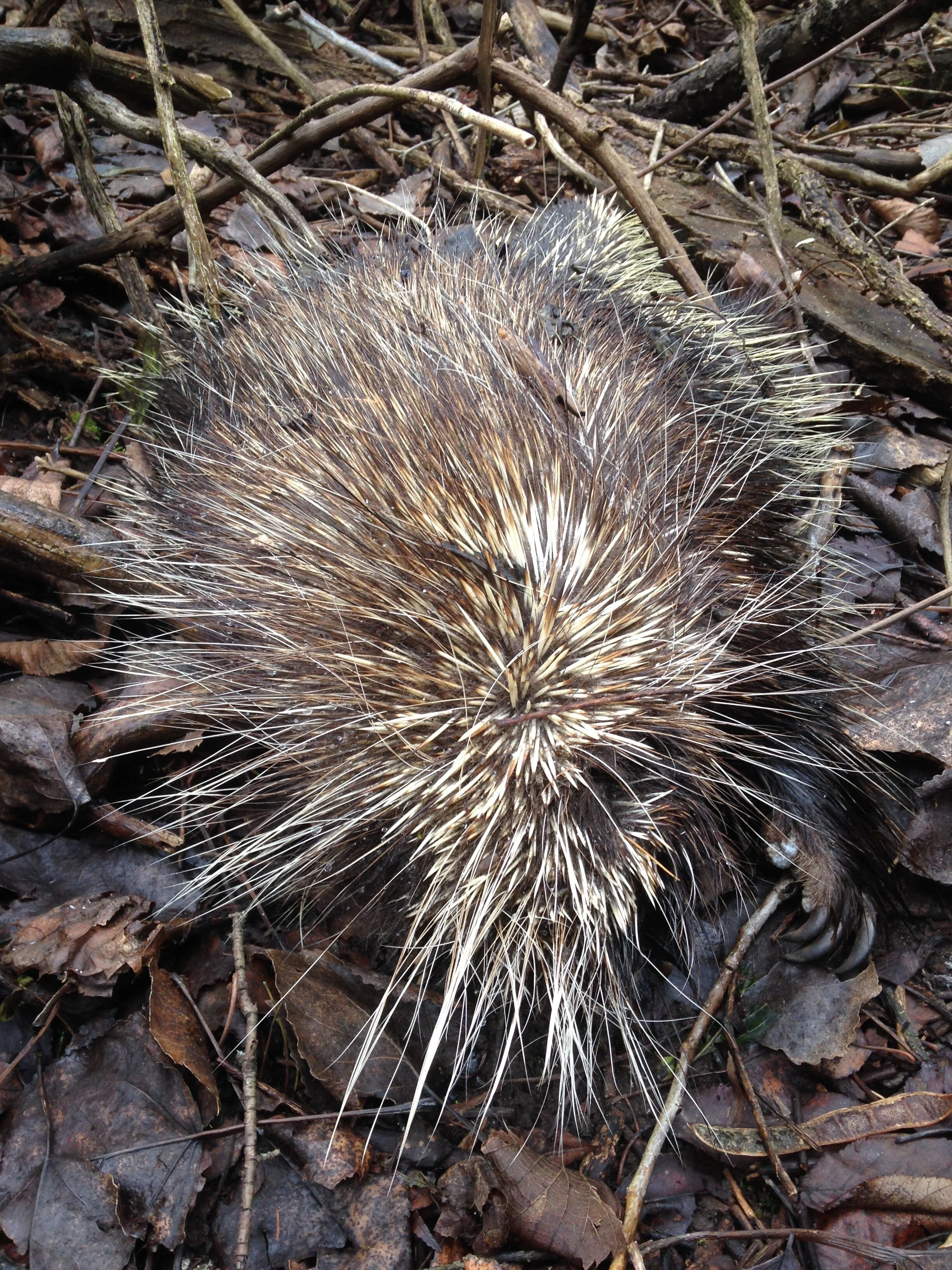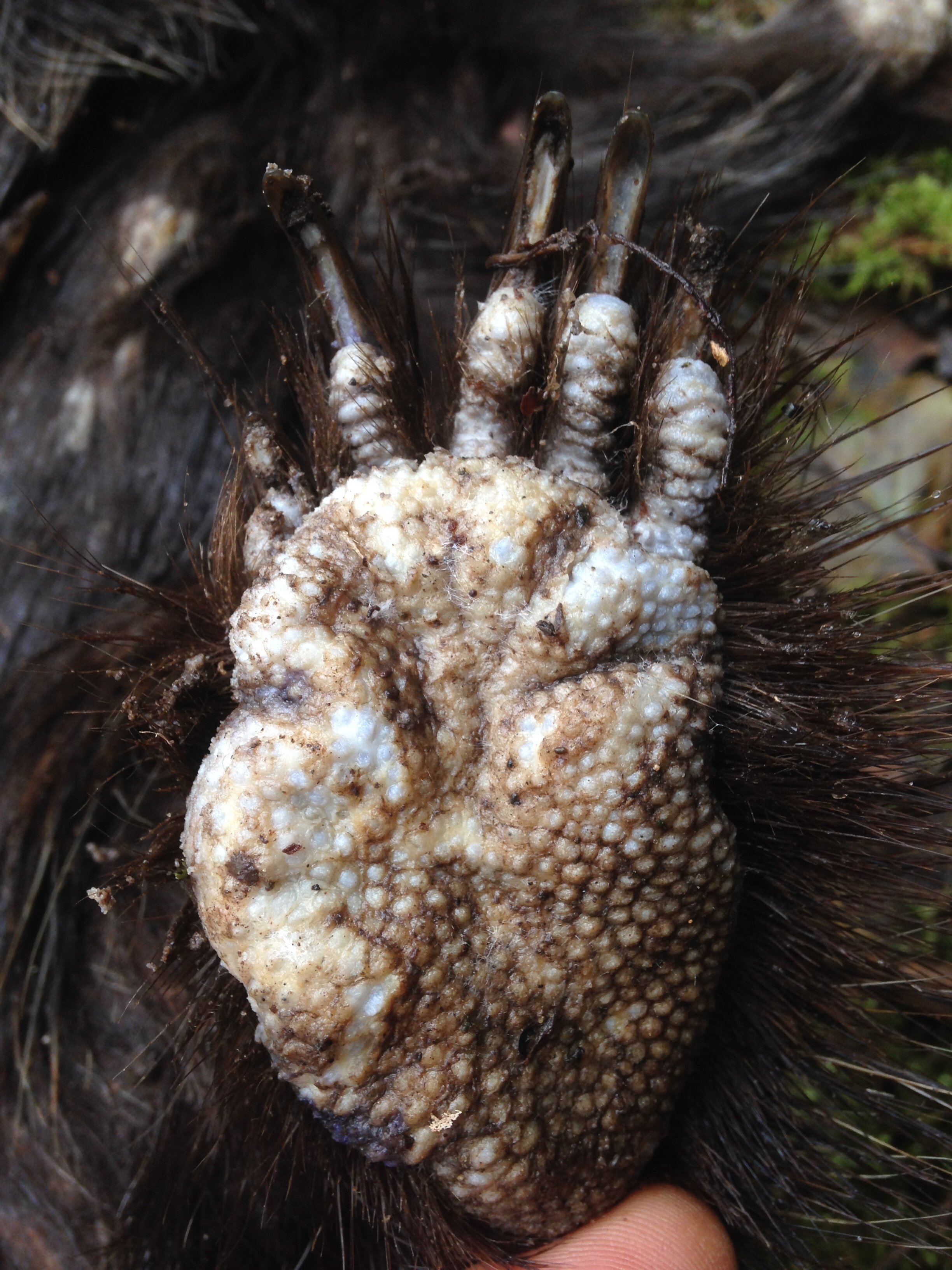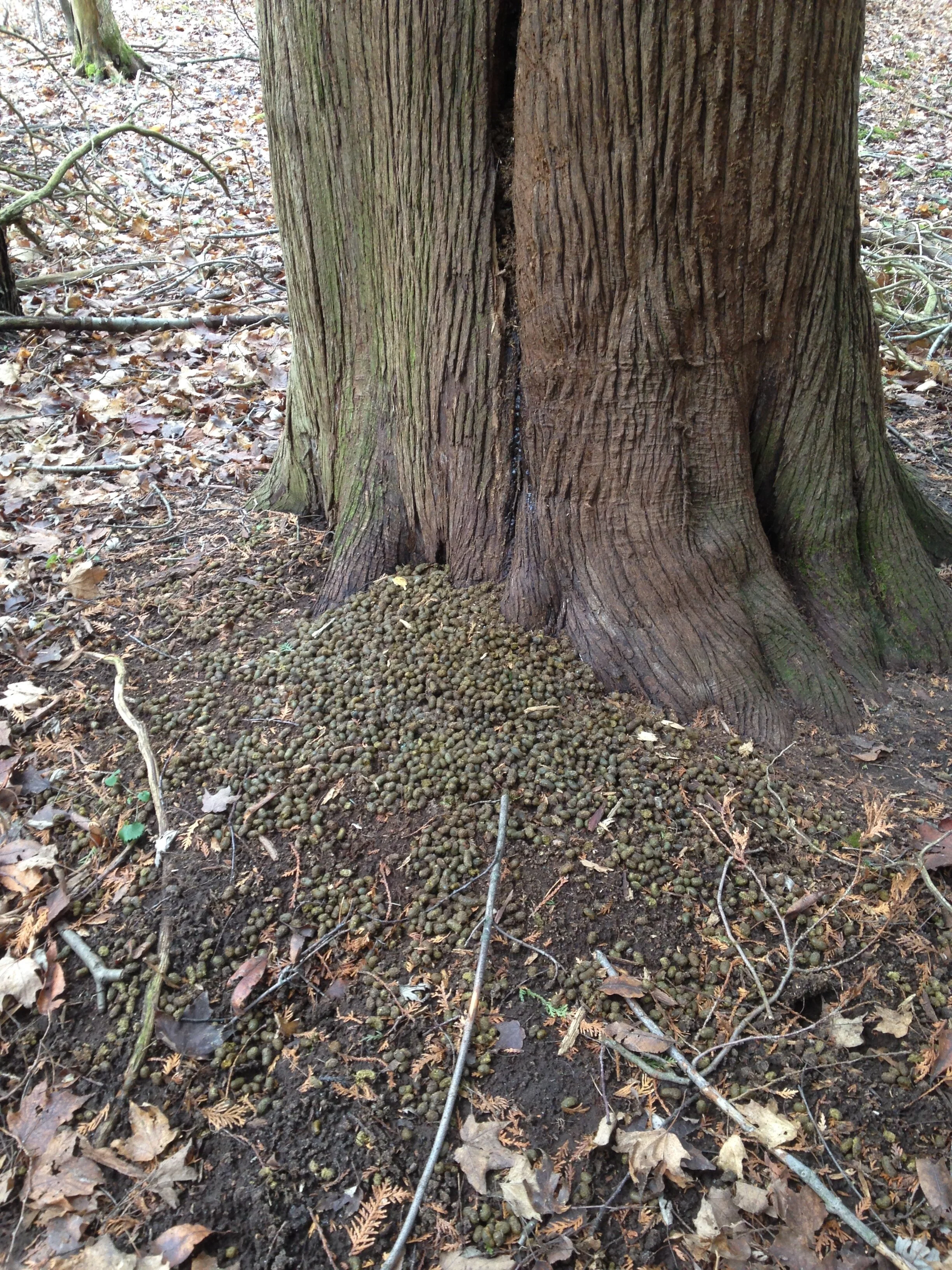Tracking journal December 13, 2020
Yesterday : Rainy, high of 9, wind from the East.
Today : 0 degress celcius, Overcast. Wind from the W at 20 km/h, gusts 40. Wet cold.
I got out of the car and began making my way to the woods. There are some areas on the way where I am sure it would be preferred I not go, but this was the fastest, safest way so I was quick and discrete. As I climbed a bit of a gravel hill I got to the slope of the hill, where one side of the property is bounded by a Cedar tree line. As I came down I was looking lightly but most just making my way back towards the woods, when I came across a set canid of tracks.
From first glance my thought was Coyote (Canis latrans). But I have been mistaken many times before. But this time it seemed like they were just too big for a Fox (Vulpes vulpes)? I have have seen lots of signs of Foxes in the area, and a friend told me she saw one crossing a busy road real close by. so I didn’t want to push out the possibility. Even though my hands begged for my gloves (the wet cold really bothers me), I pulled out my tape measure and took some measurements.
Right Front: 70 mm L x 61 mm W
Right Rear: 75 mm L x 45 mm W
These track sizes would indicate Coyote. Too big for a Fox. These measurements didn’t make sense to me. Why should the larger looking front track measure smaller? I looked close and saw that the metacarpal was probably hinged a little on the white stone, thus warping the look of the track. So this measurement was not of a full track. I asked myself some other questions too, like how do I know which track is the front or rear, and how do I know that they are right feet?
I can tell front from rear by size. Coyotes and other canids are front heavy, as the forelimbs (thoracic limbs) carry about 60% of the body weight when the animal is standing still. The forelimbs are designed for absorbing the impacts of hitting the ground. They are also shorter than the hind limbs (pelvic limbs).
There are a couple of ways to tell the right feet from the left feet. Easiest way is to look at the trail of the animal and imagine an line running down the centre of the trail. You can see which ones land on the left side of this line, and which would land on the right. Another way to tell is to look at the toes. Toe 3 is often a little bit bigger than the others, kind of like a lot of people. Here is are the same tracks with the toes labelled:
Toes numbered from the inner toe (2) towards the outer toe (5)
I studied these tracks a little bit more, looking to see if I could figure out anything else from looking at them. I came up with a bunch of questions too. I was wondering what kind of gait would be used by a Coyote while they traversed a steep hill like the one I was on? The track above and the stride lengths (52 cm) seemed to show a side trot, which could be interpreted as the Coyote being on a mission, going somewhere, and picking up the pace. I wonder how often side trots are used going up inclines like the hill I was sitting on? Wouldn’t a bounding gait be a little bit easier? I have seen trails of Coyotes bounding uphill in deep snow before, but I don’t know if I have ever seen a bounding gait going uphill without the deep substrate. Something to look out for in the future.
I kept walking on through the mud and gravelly areas, slipped a couple of times and then finally crossed an old wire “cow fence” into a grassy field slowly giving way to Scots Pine (Pinus sylvestris), Eastern White Cedar (Thuja occidentalis) and Common Juniper (Juniperus communis) and. Whenever I see the Juniper I think to Tom Wessels book, “Reading the Forested Landscape” where he talks about Juniper being an indicator species of over grazed pasture. I could imagine the old field where I was walking to have once been all in pasture and full of cows, yet let to rewild once again and filling with coniferous trees. As I wondered about the history of the field I came across a tuft of loose hair sitting amidst the Goldenrod (Solidago spp.), Wild Strawberry (Fragaria virginiana), and assorted others who I don’t know yet.
White-Tailed Deer hair
I recognized it as White Tailed Deer hair and got to thinking if I will ever make my hair journal? I also got to wondering if this was winter hair moulted in the spring, or if it was the summer coat which gets replaced by November? According to the book “The Deer of North America” by Leonard Lee Rue, White Tailed Deer start moulting their winter coats in March, but don’t really start losing the bit clumps until May. It’s totally possible that this clump of hair didn’t drop until May and as just been sitting on the ground since then. Another book, simply called “Deer” put out by Stackpole, says that Summer hair is only longer guard hairs or “primary hairs” with no wooly underfur or “secondary hairs”. The guard hairs are longer, yet the underfur is where the real insulation lies. The smaller hairs, 5x as many as the guard hairs, trap the air which warms from the Deer’s body heat. Though, all that hair is compressed and the heat is pushed out when the Deer lay down, and that’s why the snow in a Deer bed is often melted away. Back to the question of if these are hairs from the spring moult or the autumn molt… I can’t tell. I wish I’d picked through them more carefully and measured them.
Also, do any species of Birds use Deer hair in their nest construction? Seems like too a useful resource to skip out on.
Making my way past the Deer hair I meandered through the field until coming to the edge of the woods. It pretty shrubby with a couple of massive old dead Poplars (Populus spp.) along a steep decline down into the more wooded area. The bark was falling off and looked useful for carving,, but I was too distracted trying to navigate the thickety crowded edgegrowth around me. I ended up balancing along a fallen log stepping my way carefully down the hill when I noticed something below.
Can you see them?
The shape I saw didn’t quite fit the rest of the features of the tangle I was in, but it took me a moment to figure it out. It looked as though the animal had been in a tree which had recently fallen, perhaps during the big windy storm on November 15th, and this animal had possibly been thrown from the falling tree and had died due to complications resulting from the impact of hitting the ground? I can’t be sure as I didn’t check the bones and the flesh and muscles below were still a bit frozen and stiff. I hopped down from the log and went around the other side for a closer look.
Dead Porcupine (Erethizon dorsatum), fell from a falling tree?
The Porcupine (Erethizon dorsatum) was totally dead, and smelled like it too… but not too bad. They were mostly frozen as well, maybe thawed a little from yesterday’s warm spell, but mostly still hard. I really think they fell during that storm and the cold had just preserved them quite well, and since they were lying on their belly, quills up, in a thickly braided cover of branches, it would be hard for another animal such as a Coyote to get there and start breaking things down. I ended up turning the Porcupine over, pulling them into a more open and taking measurements of their feet.
Left front
Left hind
The four toed front left foot was 65 mm L x 43 mm W. The five toed hind left foot was 100 mm L x 45 mm W. There were both quite pebbly looking, kind of reminiscent of a basketball, though quite pale. I have photographs of Porcupine feet from a roadkill Porky, and the feet are much darker. The paleness must come with aging of the corpse. This one, if correct that they died since the wind storm, may have been dead for almost a month.
Another thing I see which is useful when looking at Porky tracks is how far out those claws are! Very useful for climbing trees, and they register pretty far ahead of the foot pad in the snow.
I left the Porcupine out and available for scavengers. This time of year, a larger animal like a Porcupine would likely make a couple of Coyotes quite happy.
Walking on I came to a small road and noticed some scat which caught my eye. I had seen Coyote tracks in the past along this road, both in snow, and in the smaller bits of gravel and mud. I measured the diameter (12 mm) and length (82 mm) of the scat and thought Fox at first before catching myself. I have been trying to remind myself that scat is so variable, and measurements can only offer one point of reference amidst many other possible signs or circumstance which can point to a specific species. Buttholes vary, as does diet, and the conditions with which the scat was deposited. Was the animal in a hurry? Only leaving a small deposit or were they pushing everything out?
I can guess that it was some sort of canid based on shape, twisted slightly, tapering at the ends. When I broke it up using two Goldenrod stalks it was mostly hair with a couple of bone fragments embedded within.
Since I was cold and not well dressed (I should have worn that sweater… it was out, and in my hands, but I decided against it), I chose to keep moving. I only had a couple more hours to wander about and wanted to get to a few spots before I had to get back. I made my way down an old trail and crossed over a Scots Pine which had fallen across the trail. I spooked a Ruffed Grouse, which in turn spooked me as I bent low to crawl under a Cedar and into a wider open wooded hillside. This is the part of the forest I love the best. I see many signs of different animals since I started visiting these woods and usually encounter some cool tracks or something worth paying attention to. I had the thought that I wouldn’t see any Deer around this area as the Cedar has been eaten to the point that the Deer would have to climb the tree to be able to access any of the leaves, when I saw something move up the hill on my right side. I looked over and saw a doe walking slowly away from me with her white tail held high. She paced back and forth a couple of times before I lost sight of her. Her white tail reminded me of the time I thought I may have seen a Fox around the same area last year. I had only caught the end of the Fox, the tip of the tail, white and bouncing along the trail at a trot. Seeing the doe’s white tail made me question whether it had been a Fox after all and maybe it was as it was today, just a doe walking silently away into the woods? I crept forward trying to keep as quiet as I could but ever little thing felt so loud, much louder than it likely was, but the emotional volume was deafening. Eventually I realized she was probably long gone so I began looking around again for anything to be found. I found a Porcupine quill, some scat from a male Wild Turkey (Meleagris gallopavo), and then a Cedar tree with Porcupine scat littered about the base.
I had been at this tree before… maybe late last year, while tracking with friends. There was a Porcupine denning in a hole at about 1.8 m (about 6 feet) up. I had been creeping on the Deer earlier so took to creeping up towards the tree hoping I would see another Porcupine, though this time alive.
Just the tail…
There was scratching and some clattering of claws coming from within the trunk of the tree as I approached so I knew there was a Porky inside after all. I pulled out the camera and tried to take a quick shot just in case, and lo, I got the tail as they made their way higher into the hollow. I pressed my ear to the trunk just to listen some more in case I could feel anymore scurrying about inside, but there was just silence for a couple of minutes so I moved on not wanting to stress the animal too much.
The wander continued in search of more fresh signs from animals in these seldom walked woods. I had come across many bones already here and there along the walk but there were mostly older bones with older gnaws, but nothing much really caught my eye until I came into a bit of a clearing where in I found a small pinkish bone, maybe a tibia, that had been broken on one end.

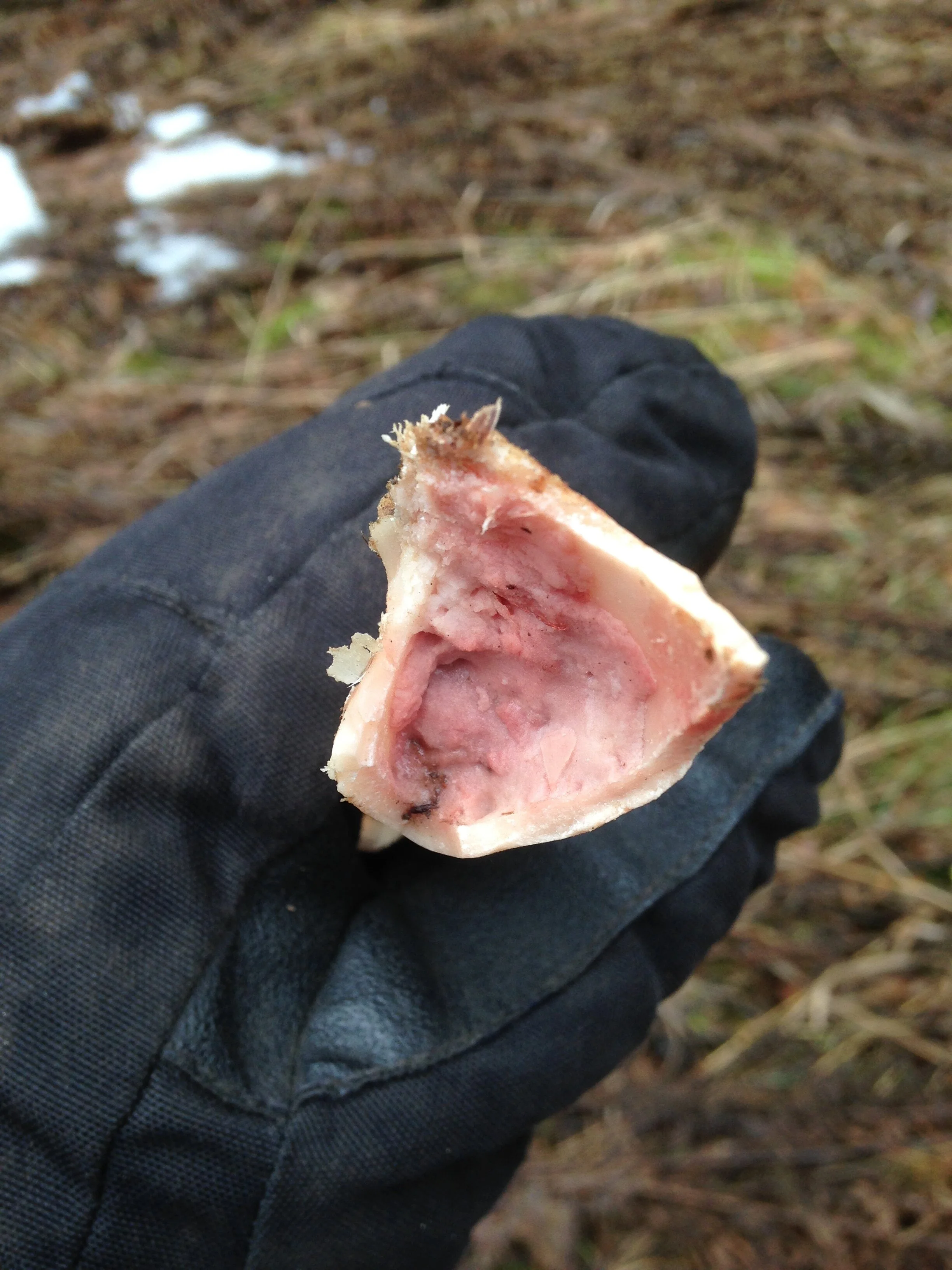
This was a cool find for me for a couple of reasons. One, it was a fresher bone, some thing that was most likely, recently alive. That’s always exciting for me. Another reason was that the bone was broken open and some of the marrow removed. I often find old bones that have been visibly sawed/butchered but to find them broken like this implies non-human animals and that gets me a little more excited. Finally, another reason for my excitement was the state of the marrow in the bone. It was pink! I learned last winter that the if the marrow in the bone is pink, than that could mean that the animal was starving and that their body began using up fat resources in the bone. But, in my research to learn more, I am finding sources that challenge this. I would really like to learn more about this phenomena and try and understand it a little more deeply. I love when the things I find out on tracking missions inspire more questions and get me looking a little deeper.
I ended up doing a wide figure eight around the area looking for more signs of this dead animal but discovered nothing and finally got distracted by the pull of gravity (I could go downhill, or uphill… I went downhill).
I slipped into an easy going downhill pace and didn’t pay much attention to my surroundings when I suddenly spooked two large birds from their roosts. The began making quite a racket, hootin’ and hollering, flying down from separate perches onto a single log and then one flew off back to their perch. When that one flew back down to the log again I saw the face for the first time and realized quickly that these were Barred Owls (Strix varia)!! I pulled out my phone quickly trying to get a photo to show everyone who has been showing me their own photos of Barred Owls seen lately, but it was too late. They both flew off into the distance beyond sight. But I could still hear them.
I kept on quietly stalking in the direction the two Owls had flew off in, and heard a Red Squirrel (Tamiasciurus hudsonicus) give an alarm call. I knew it was for me as the Owls had flown off already. I tried to cross a small creek but the ground was wet, the creek wetter, and I was only in my everyday shoes and it was too cold to venture in just to harass a couple of Owls. I took joy in the wild sighting and made my way through the wet swampy edges until I came across an old unexpected friend.

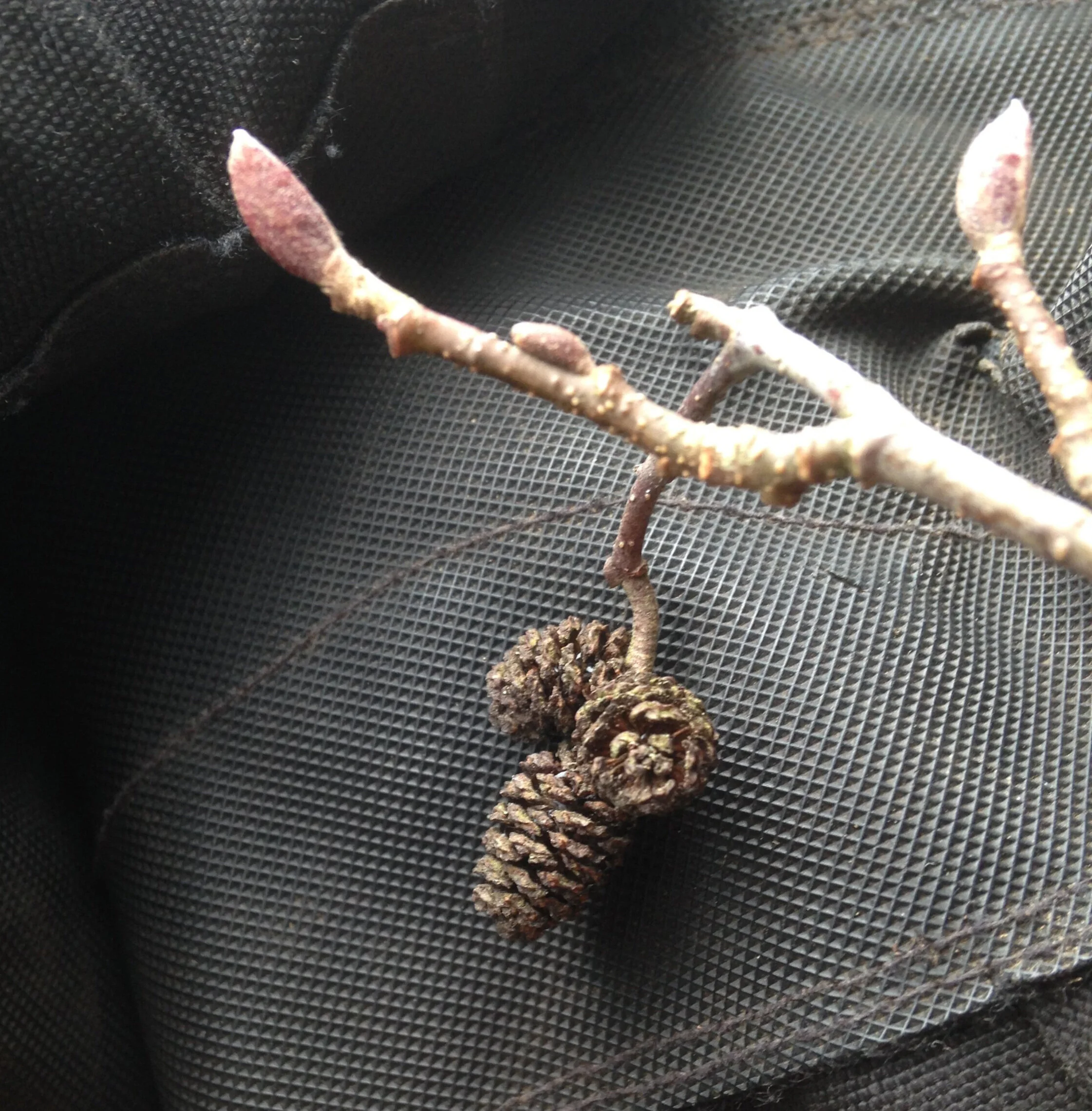
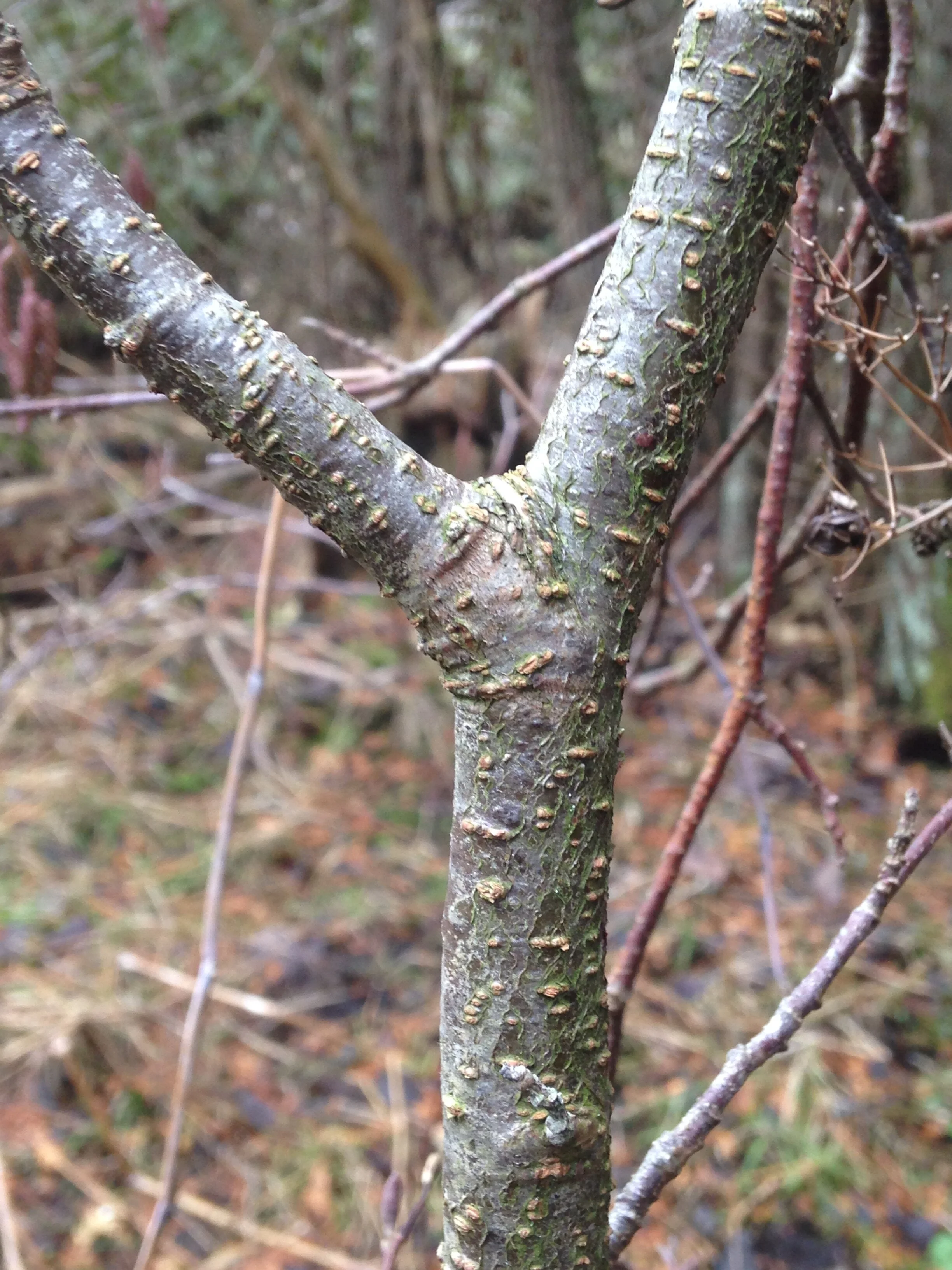
Speckled Alder (Alnus incana ssp. rugosa) is not a shrub I see a lot, but they are a shrub I like to see. The long male catkins are what first caught my eye as I was mostly looking down, but saw them dangling from the shrub. The second photo is of the female catkins which sort of start out green in the summer and then once fertilized open up releasing winged nutlets, and then the female catkins harden, start looking like Pine cones, and end up hanging on the shrub for a while.
Some cool things I’ve been learning about in my research since seeing this shrubs:
Alder seeds are eaten by Black Capped Chickadees (Poecile atricapillus), American Goldfinch (Spinus tristis), Redpolls (Acanthis), Pine Siskins (Spinus pinus) and American Woodcock (Scolopax minor) also known as a “Timberdoodle”.
Alders are in the Betulaceae family, along with Birch (Betula spp.), Hazels (Corylus), and Hop Hornbeams (Ostrya).
Speckled Alder is called “Wadoop” “or “Adoop” in Ojibwe
Speckled Alder is a nitrogen fixer, similar to the shrubs in the Olive (Oleaceae) family
folks use the inner bark of the Speckled Alder to make red dye.
I ended up leaving the Speckled Alder and making my way back. I still had to meet someone and then head home, so I turned and walked the forest bottom, adjacent the creek, for a while, stopping to look at bones and feathers I was finding. I did take a slight detour and headed up towards an area with a large den which hadn’t been used in the past while. I always check this den because you never know who might have visited or what might be near. I have found a Coyote skull nearby, and also a dead Muskrat (Ondatra zibethicus) among other interesting finds.
I came to the dens quietly from a roundabout way and walked up cautiously, just in case anyone might be using them. I didn’t expect anyone, but there is always a chance. As I got closer, the weeds about the dirt mounds just outside the openings were missing in their robustness which I had seen in the summer. Perhaps someone was using them? It’s only now that I remember that the weeds are likely missing because they’ve died off for the year.
As I got closer I did see some cool things about the dens. One, was scat. Lots of it, piled over time between two entries, as if someone was claiming the spot before the winter and mating seasons really came on.
The other thing I found which I thought was interesting were a small group of four tracks emerging from the den. They weren’t anyones tracks who I had seen around the dens in the past, but instead someone new. If I remember correctly, and I should have written it down, the tracks were about 3 cm long which threw me off because they looked like Striped Skunk (Mephitis mephitis) tracks. It’s the shape of the tracks, and the way the nails stick out pretty far on the front feet that look so much like Skunk, but the size… I do remember reading, in the new edition of Mammal Tracks and Sign by Mark Elbroch, that they mention they don’t bring measuring tapes into the field anymore because the sizes of tracks vary pretty widely and cannot be counted on too severely. I think for my own sake I can ditch the 3 cm, and just know by the look of the tracks, by other associated signs, by the process of elimination that these must be Skunk tracks. Who else could it be?
I left with wonder and curiosity thinking I’ll check my notes when I get home, when I passed more bones, an antler rub, some tracks in the snow, and finally, just after crossing the stream once more, some red scat.



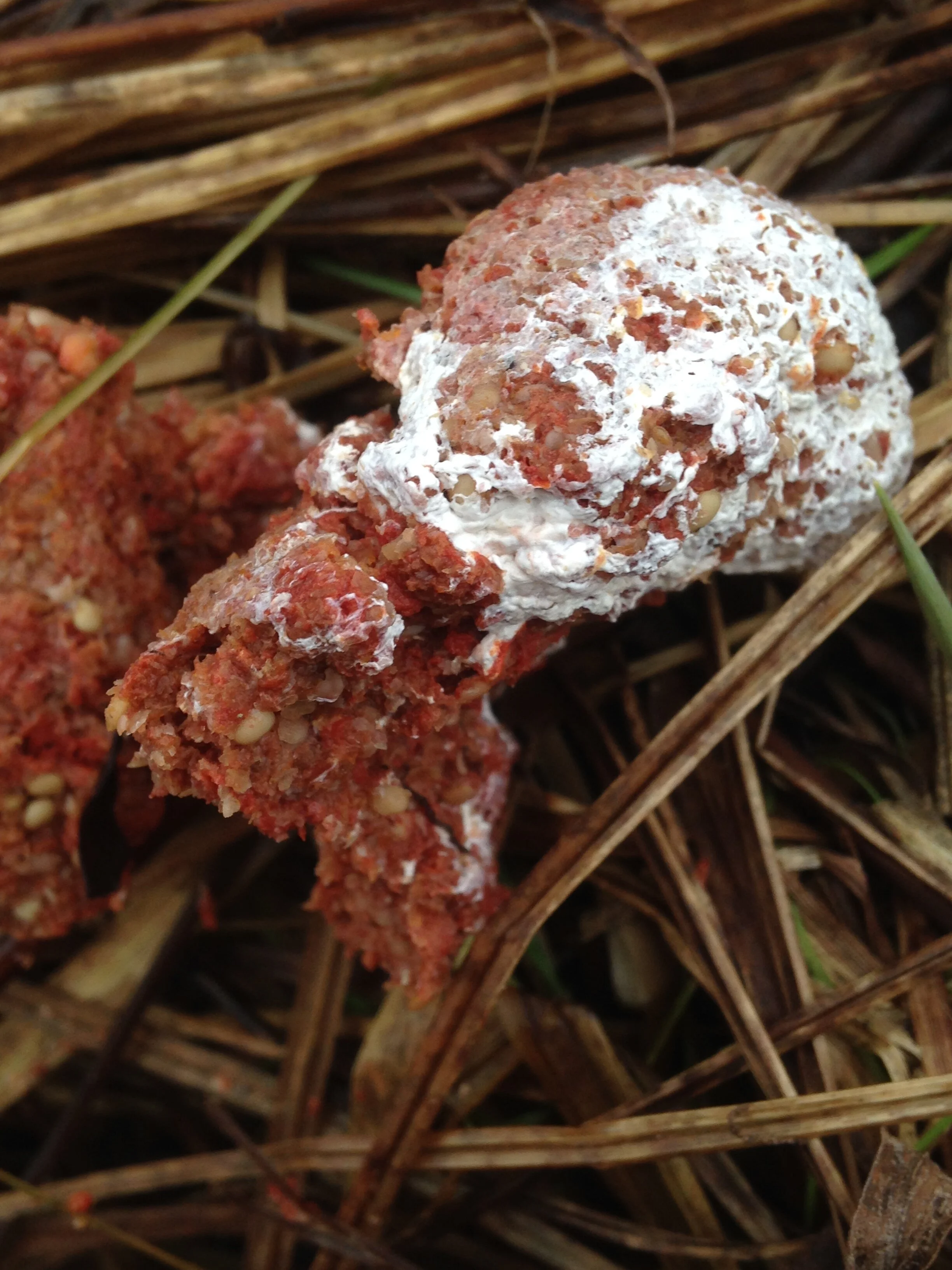
Even though I was feeling in a bit of a hurry to get back I couldn’t resist taking a look at this scat. It was so red! I figure it was more Turkey scat, but the redness. Since I was still close to the creek, and it was a bit of a swampy wetland, and the scat was red, and the seeds were many, small, round and pale, I thought the food ingested must be Bittersweet Nightshade (Solanum dulcamara). I have squished many of the Bittersweet berries with the kids I teach trying to get them to note the difference between the Bittersweet seeds and the seeds of Highbush Cranberry (Viburnum opulus). Bittersweet is considered inedible, and potentially poisonous, for humans, where as the Highbush Cran just tastes bad. This is the first time I have seen the seeds of the Bittersweet in the scat of an animal and it was exciting to note that someone is eating the fruits which grow so commonly and abundantly. Gets me wondering who else is eating them?
Now it was truly time to go. I knew I was going to get distracted by something on the way back and so I hurried along, quickly looking at mushrooms and lichens along the way wishing I knew more about them and their interactions with the plants and animals around them, but that would have to wait for another time.
These tracking missions are a ton of fun. I learn so much if I give myself the time to wander without aim or goal. If I just follow the shape of the land I am often led to amazing finds which teach me and continue to inspire me long after I’ve left.



